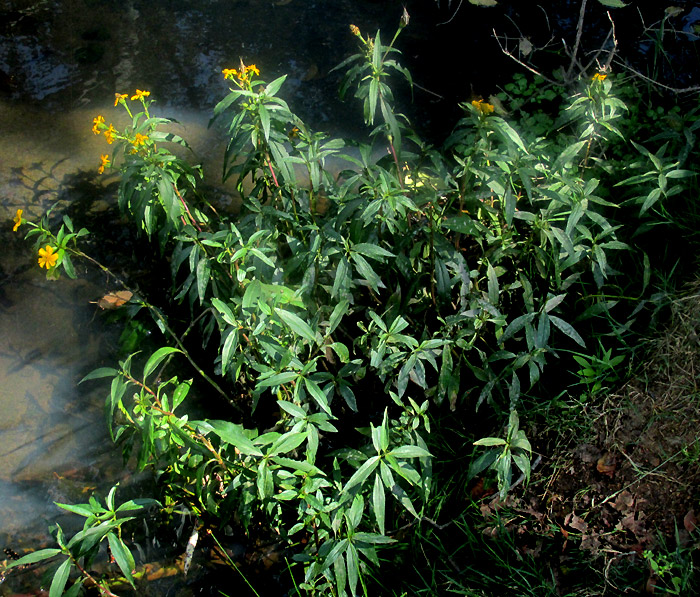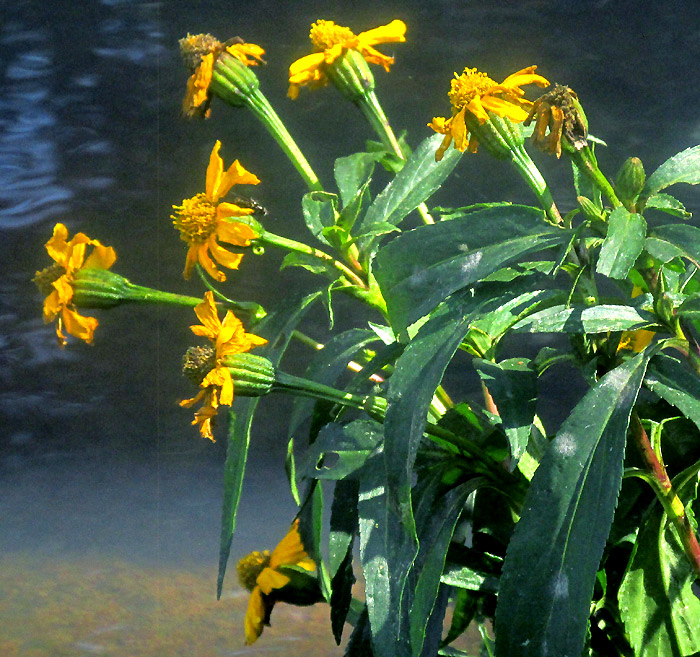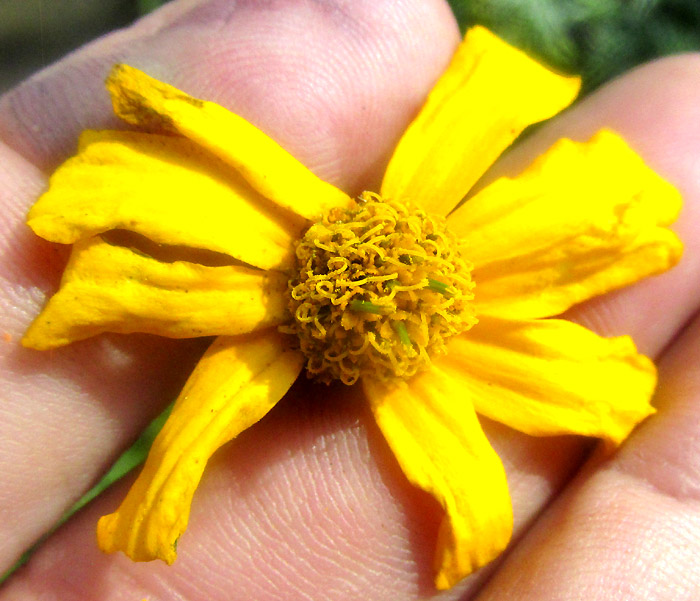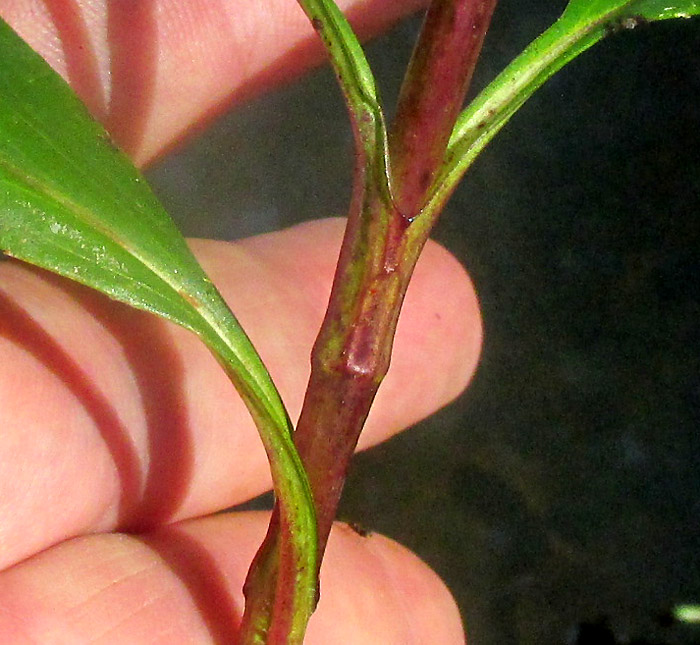Excerpts from Jim Conrad's
Naturalist Newsletter
Entry dated November 7, 2023, from notes taken at Cascadas de La Piedad waterfall 3kms NW of the community of San Pablo, municipality of Almeaco de Bonfil; bedrock of igneous andesite; N20.1008°, W100.0041°, elevation 2360 meters (7750ft); extreme southern Querétaro state, MÉXICO
TAGETES PERSICIFOLIA

Even during the ongoing two-year dry period classified by the North American Drought Monitor as an extreme D3 drought, a small stream of clear, cold water meandered among livestock-grazed meadows and cornfields atop the valley's bed of pinkish, igneous andesite rock. Just before tumbling over a high ledge to create the picturesque Cascada de La Piedad, or Piety Waterfall, the above wildflower was thriving in a mostly shaded spot at the water's edge, inside a narrow band of bushes and trees along the stream.

With yellow, petal-like ray florets at the flower clusters' margins surrounding center "eyes" composed of numerous, tightly packed, cylindrical disc florets, this was clearly a member of the largest of all plant families, the Composite-Aster-Sunflower Family, the Asteraceae.

In the 2018 study by José Luis Villaseñor entitled "Diversidad y distribución de la familia Asteraceae en México," it's said that "Mexico currently records 26 tribes, 417 genera and 3,113 species of Asteraceae, of which 3,050 are native species and 1,988 (63.9 %) endemic to this country." To distinguish one species among Mexico's 3,113, usually you really have to "do the botany." The flowering head, or capitulum, shown above, while pretty, couldn't be more typical of the family, and doesn't help much with identification.

In contrast, the green involucre shown above enveloping the florets' lower parts shows some good field marks for identification. Usually Aster Family involucres are composed of two or more series of scale-like bracts, which overlap like roofing shingles as they spiral around the involucre. Our plant's involucre consists of only one series of long, slender bracts, all of the same length. Moreover, the bracts appear to be fused along their common margins, not separated from one another as usual. Finally, the bracts' surfaces are bumpy, and the bumps tend to be darkly splotched. The bumps are glands, not seen on most Aster Family species.
In Mexico, when you see an Asteraceae with yellow florets and this combination of involucre characters, you need o think "Tageteae." That's one of the family's 26 Mexican tribes, embracing 27 genera and 173 species. All members of the Tageteae are native only to the Americas, and the tribe's center of diversity lies here in the Mexican highlands. The Tageteae is home to Mexico's numerous marigold species. Knowing the tribe, from 3,113 candidate species, the possible identities are narrowed down to 173.

Crumbling apart a flowering head, florets in the palm of my hand displayed no slender hairs or needles forming a pappus atop each slender, greenish, immature developing cypsela-type fruit. However, notice the ray floret whose yellow, flat corolla originates in the above picture's lower, right corner. Where its corolla attaches to the immature cypsela, five very short scales atop the cypsela form the pappus; such low, crown-like pappuses are possible in the Tageteae, though other species produce different pappuses.

One flowering head on the plant had formed mature cypselae. Above, you see them stacked next to one another in the broken-open head. No scale-like paleae separate the cypselae from one another, which is right for the Tageteae. Especially near the picture's right margin, a low crown of pale pappus scales is seen atop a brown cypsela.

Pairs of leaves arising opposite one another on stems is common in the Tageteae but, above, it's seen that leaf blades continue down the petioles' sides, forming green "wings." It's very unusual that the sides of the wings of each leaf connect with one another well above the leaves' bases at each stem node, forming a cylinder around the stem. The cylinder extends down to the stem node, which is evident bulging out the cylinder encircling the stem.
In the 2003 treatment of the Tageteae Tribe in the Flora del Bajío, the above features -- especially the leaves' blades joining one another above the stem nodes, and the five low teeth forming the pappus -- lead directly to the genus Adenopappus. The above-mentioned remarkable details of pappus and leaf bases contribute to making the genus "monotypic," meaning that the genus is home to just a single species; that species is Adenopappus persicifolius.
However, in 2003, genetic analysis indicated that the genus Adenopappus, thus our plant, resided inside the branch of the Phylogenetic Tree of Life designated as the genus of Tagetes. This indicated that our plant needed to be transferred into Tagetes; currently its accepted name is TAGETES PERSICIFOLIA. Tagetes is the marigold genus, so our plant is a real marigold, but with no distinctive English marigold name just for itself.
In the Flora del Bajío, Tagetes persicifolia -- under the name of Adenopappus persicifolius -- is described as "poco frecuente," or "somewhat uncommon." It's said to occur in the beds of usually-dry streams, along river and canal banks, and in gardens and cultivated fields. The species is endemic just to the highlands of central Mexico.
I find no mention of traditional uses of our plant. However, people always have appreciated certain marigold features. Their flowers contribute bright colors to gardens, and their long-lasting blossoms are used as decorations in various celebrations. Here in Mexico the flowers' brightness attract wandering spirits to the homes of ancestors remembering them during Day of the Dead events. The blossom' orange-yellow color, produced by the carotenoid compound called lutein, is used as a food coloring. Marigold species often possess chemical compounds which may be toxic and thus useful for pest control, or fragrant enough to be used in perfumes, or flavorful enough to be used as seasoning.
And of course in the wild, untold numbers of pollinators and leaf-eating invertebrates benefit from their presence.